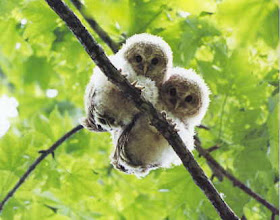| Cuddle cuddle. |
Owls are found almost everywhere in the world, except Antartica and parts of Greenland. These cute birds have big, round eyes, for seeing at night. Owls can rotate their head almost all the way around in a circle! This helps owls see because they cannot move their eyes from side to side.
 |
| Cute little owly hiding in a tree. |
Most owls spend their time by themselves, and are usually active at night. They sleep all day and wake up at night to catch rodents and little birds. There are a few owls that fly around in the day, and some that are most active around dawn and dusk.
Some owls have special feathers that make the bird's flight silent! The edges of some of their feathers are jagged, which reduces the noise from the flapping wings. This means that they can sneak up on their food!


